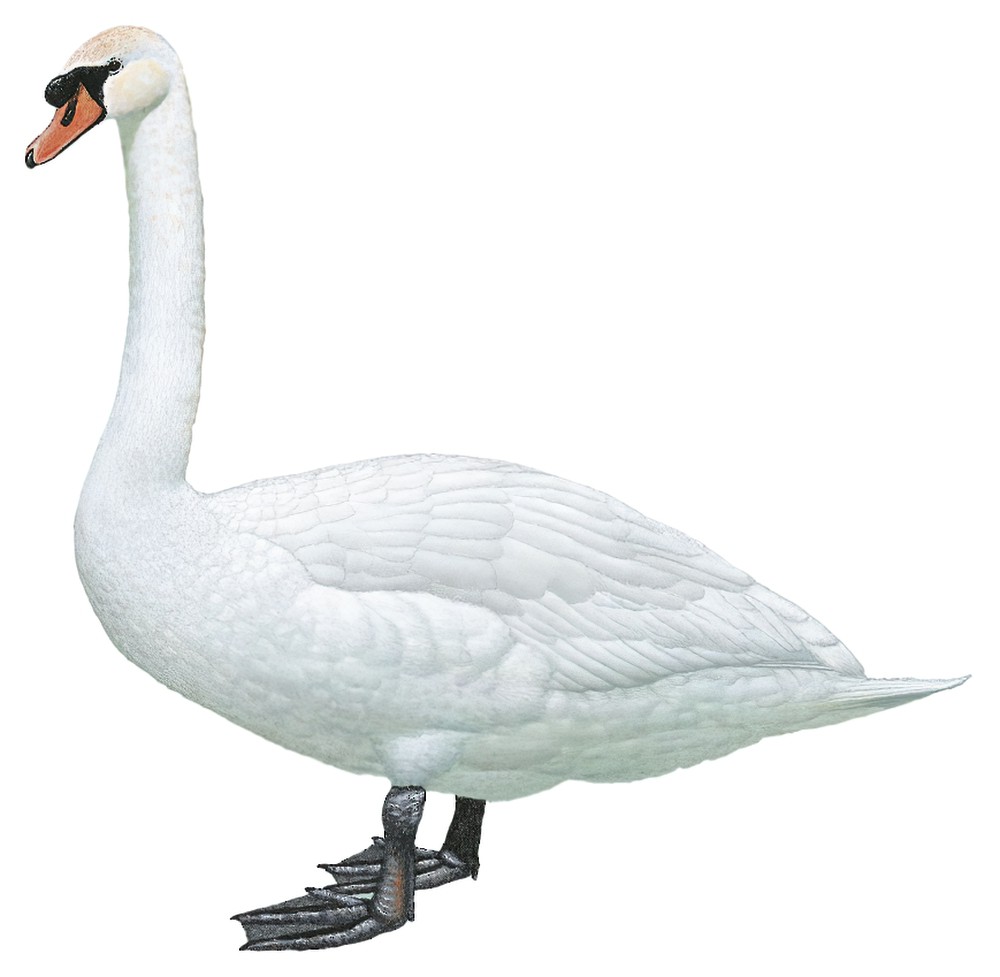Mute Swan / Cygnus olor

Mute Swan
SCI Name:
Protonym: Anas Olor Syst.Nat. 1 pt2 p.502
Taxonomy: Anseriformes / Anatidae / Cygnus
Taxonomy Code: mutswa
Type Locality: Russia, Sibiria, Persico etiam littore maris Caspii.
Author: Gmelin, JF
Publish Year: 1789
IUCN Status: Least Concern
DEFINITIONS
CYGNUS
(Anatidae; Ϯ Mute Swan C. olor) L. cygnus or cycnus swan < Gr. κυκνος kuknos swan (cf. Gr. myth. Cycnus: at least three persons of this name were metamorphosed into swans, i.e. a son of Neptune by Calyce, a son of Apollo by Hyrie, and a son of Sthenelus of Liguria). Wild populations of the Mute Swan are now absent from much of western Europe; "β. Cygnus ferus LINN. The wild swane. Der wilde Schwan. (Seligm. Cat. V. T. 44.)" (Zimmermann 1793); "* 1. Stummer Schwan (A. Olor, Gmelin Linn,): Mit schwarzem, halbwalzenförmigem Schnabel, schwarzer Wachshaut, und schneeweißem Körper. 4½ Fuß lang. ... 1) Die Gattung Schwan (Cygnus) hat einen etwas schaufelförmigen Schnabel mit Lamellen statt der Zähne, einen langen Hals und Füße, die etwas außer dem Gleichgewicht liegen." (Bechstein 1803); "Cygnus Bechstein, Orn. Taschenb., pt. 2, 1803, p. 404, note. Type, by monotypy, Anas olor Gmelin." (Peters, 1931, I, p. 143).
Var. Cignus, Cyenus, Cygnos.
Synon. Archaeocycnus, Chenopis, Clangocycnus, Cycnus, Cygnanser, Euolor, Olor, Palaeocycnus, Sthenelides, Sthenelus.
cygnus
L. cygnus or cycnus swan < Gr. κυκνος kuknos swan. Gr. myth. Cycnus or Cygnus, the son of Sthenelus king of Liguria, was sorely afflicted by the death of his friend Phaëthon and was metamorphosed into a swan. In other versions of the story Cycnus, son of Apollo, in a fit of pique at not getting his own way, threw himself from the heights of Mt. Teumessus and was changed into a swan, as was Cycnus, son of Neptune, when he was slain by Achilles.
● Swan I., Victoria, Australia (syn. Anthochaera rufogularis).
● "61. ANAS. ... Cygnus. 1. A. rostro semicylindrico atro, cera flava, corpore albo. Fn. svec. 88. It. wgoth. 143. Cygnus ferus. Bell. av. 30. a. Gesn. av. 372. Aldr. ornith. l. 19. c. 1. Will. orn. 212. . . Raj. av. 136. Alb. av. 3. p. 91. t. 96. Edw. av. 150. t. 150. β. Cygnus mansuetus. Will. orn. 271. t. 69. Raj. av. 136. Habitat in Europa, America septentrionali. Accedit ad nos ultimo die regelationis. Piscatur pomo. It. scan. 186. 228." (Linnaeus 1758) (Cygnus).
olor
L. olor, oloris swan; ex “Mute Swan” of Latham 1785, and Pennant 1785 (Cygnus).
Olor
L. olor, oloris swan.
● (syn. Cygnus Ϯ Whooper Swan C. cygnus) "40. Genus Olor Wagl. Schwan. Der Oberkiefer ohne Nagelkuppe; die Stirn ohne Höcker. Species: 1. Ol. musicus (Cygn. music. Bechst.) - 2. Ol. Bewickii (Cygn. Bewickii Yarrell Zool. Journ. 1830. p. 189.*) - 3. Ol. Buccinator (Cygn. Bucc. Richards. Fauna Boreali-Americ., Yarrell Philos. Mag. 1832. p. 287.)" (Wagler 1832); "Olor Wagler, Isis, col. 1234, 1832—type, by subs. desig., Anas cygnus Linnaeus." (Hellmayr & Conover 1948, XIII, 283). Var. Holor.
● (syn. Plectropterus Ϯ Spur-winged Goose P. gambensis) "Alle Schwäne besitzen große Kraft zum Schlagen mit den Flügeln, die größte aber wohl der mittelafrikanische, (C. gambiensis,) bei welchem das Handgelenk mit einem starken Hornstachel bewaffnet ist. Er mag vielleicht nicht der einzige fremde Schwan sein, der als besondere Gattung (Olor) angesehen zu werden verdienen dürfte" (Gloger 1842).
UPPERCASE: current genus
Uppercase first letter: generic synonym
● and ● See: generic homonyms
lowercase: species and subspecies
●: early names, variants, mispellings
‡: extinct
†: type species
Gr.: ancient Greek
L.: Latin
<: derived from
syn: synonym of
/: separates historical and modern geographic names
ex: based on
TL: type locality
OD: original diagnosis (genus) or original description (species)












